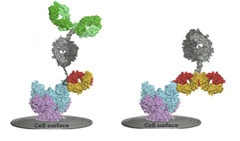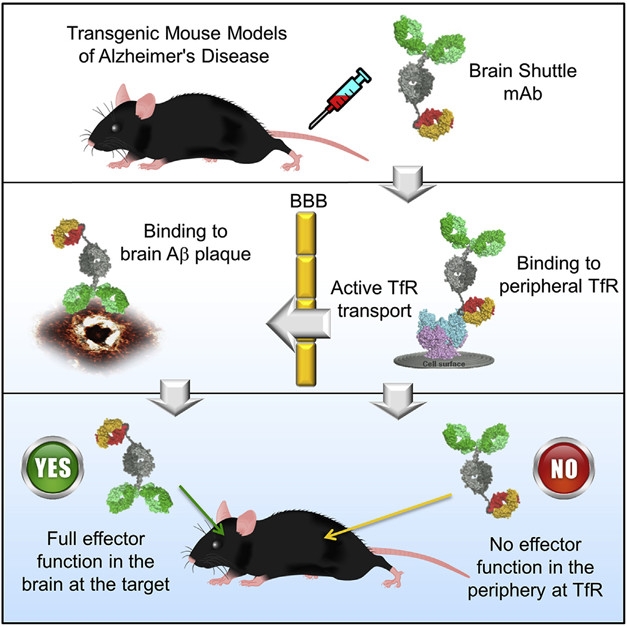Antibody Shuttle Rouses Anti-Aβ Response in Brain without Waking the Periphery
Quick Links
Like a well-mannered soldier hitching a ride to battle, Roche’s anti-Aβ “Brain Shuttle” antibody remains quiescent until it enters the central nervous system, according to a January 2 paper in Cell Reports. Researchers have been concerned that this antibody may trigger a harmful immune response against cells expressing the transferrin receptor, which serves as the basis for the shuttle. Au contraire, say scientists led by Per-Ola Freskgård at the Roche Innovation Center in Basel, Switzerland, who report that no such response came to pass. The findings raise hope that modifying existing anti-Aβ antibodies with brain-shuttle capability might ramp up drug delivery to the brain without killing innocent bystanders on the way.
- An anti-Aβ monoclonal fused with an antibody fragment for the transferrin receptor (TfR) gains entry into the brain.
- There, it binds Aβ, then triggers plaque clearance by engaging immune cells.
- The antibody triggers no effector responses against TfR.
“This fundamental work has very important implications for increasing the efficiency and safety of antibody treatments for CNS disorders, particularly Alzheimer's disease,” commented Roy Weller of the University of Southampton, England.
Roche’s Brain Shuttle is one of many efforts to take advantage of the TfR to smuggle therapeutics across the blood-brain barrier (BBB). This feat would be especially useful for bulky monoclonal antibodies, which poorly penetrate the brain, generally at well under 1 percent of the injected dose. Expressed on the epithelial cells that line blood vessels in the brain, TfR ferries its ligand—usually transferrin—into the brain via a process called transcytosis. To take advantage of this, Roche designed the Brain Shuttle, a protein construct that fuses a single Fab fragment of a rat antibody specific for mouse TfR to the Fc end of mAβ31, a human IgG1 antibody specific for Aβ fibrils and oligomers. This antibody is the preclinical version of gantenerumab.

Fab(ulous) Hindrance.
When the Brain Shuttle (red/yellow) engages the transferrin receptor (blue), the Fab arms (green) of mAβ31 interfere with binding of the Fc stem (gray) to receptors on immune cells. The Fc stem is unhindered in a bivalent TfR antibody (right). [Courtesy of Weber et al., Cell Reports, 2018.]
In 2014, Roche reported that the Brain Shuttle (BS) ramped up delivery of mAβ31 into the brains of PS2APP mice, where it boosted plaque clearance. In that model, the Fc region of the antibody played a pivotal role in inducing brain-resident microglia to mop up the plaques via phagocytosis (Jan 2014 news). However, subsequent studies with different anti-TfR constructs reported that TfR-expressing cells, including fledgling blood cells, also fell prey to the effector response, and were being lysed by the antibody (May 2013 news). Freskgård wanted to investigate whether harmful responses were triggered by their shuttle.
Surprisingly, first author Felix Weber found that unlike a bivalent anti-TfR antibody, BS-mAβ31 induced no lysis of cells expressing TfR. Interestingly, when the researchers removed one of the mAβ31 Fab arms, an intermediate level of lysis occurred, suggesting that the Aβ-specific Fab arms were protective.
The same was true in humanized FcγR mice, which express several human Fc receptors known to mediate effector functions. The researchers turned to these animals to rule out negative consequences of peripheral engagement of the shuttle with bona fide human receptors. Again, bivalent TfR antibodies, but not BS-mAβ31 or effector-less antibodies, triggered an acute drop in temperature, a burst of cytokines, and body-wide release of reactive oxygen species (ROS) in the human FcγR mice. Dialing up or down the number of Fab arms on mAβ31 revealed that these fragments were responsible for blocking the harmful inflammatory reactions. However, Freskgård told Alzforum that they have not yet investigated how BS-mAβ31 affects reticulocyte numbers, which are slashed by bispecific anti-TfR antibodies (May 2013 news).
Despite eliciting little immune response against TfR, the shuttle still worked as an anti-Aβ antibody. In a series of in vitro experiments, Freskgård and colleagues found that the Brain Shuttle neither hindered the mAβ31 portion from binding to Aβ, nor stymied its Fc domain effector function. After binding Aβ, BS-mAβ31 engaged Fcg receptors on co-cultured macrophages, stimulating these cells to pump out cytokines and engulf plaques. The researchers speculated that when the BS-mAβ31 Fab fragments bind Aβ its Fc region is free to interact with FcγRs on cells, but the opposite is true when the antibody engages TfR. In this scenario, they hypothesized, the Fab fragments hinder interactions between the Fc moiety and the FcγRs. “The Brain Shuttle interacts very differently with FcγRs than a typical anti-TfR antibody does,” Freskgård told Alzforum (see image above). He added that they have found the same is true when antibodies other than mAβ31 are tethered to the shuttle.
Does this make for a promising therapeutic? Weber dosed APP London mutation mice once weekly for four months with 2mg/Kgs of mAβ31 or an equimolar dose of 2.7mg/kg of BS-mAβ31. Dovetailing with a previous finding in a PS2APP model, he found that seven days after the last injection, mice had 12-fold more shuttle in the brain than mAβ31, and a lower plasma level. BS-mAβ31 also cut the number of plaques in the cortex by a third, while mAβ31 at the doses used in this study did not significantly affect plaque load.

Effect Inside Brain Only. On the walls of blood endothelial cells outside the blood-brain-barrier (middle panel, right), the modified therapeutic antibody (red/yellow) interacts with transferrin receptor (blue). Only in the brain parenchyma, the antibody’s Fab arms (green) latch onto plaques, and its Fc stem (gray) triggers an effector response in resident immune cells. [Courtesy of Weber et al., Cell Reports 2018.]
The researchers are conducting further preclinical studies to assess both the safety and potential efficacy of BS-mAβ31, including studies in AD model mice crossed with humanized FcγR animals. Freskgård told Alzforum that Roche has not yet decided whether gantenerumab will be the Brain Shuttle’s clinical debut, as therapeutics for other indications are also being considered. Gantenerumab itself, without the transport boost described here, is in Phase 3. Roche is conducting clinical studies to assess the safety of higher doses of gantenerumab than used previously (Dec 2017 conference news). Freskgård noted that with brain-shuttle technology, it may be possible to reduce doses of the drug by at least 10-fold, which would offer a better safety profile.
Other shuttles are in the works as well. On January 5, Denali Therapeutics in South San Francisco, California, and Takeda of Osaka, Japan, announced a collaboration to develop up to three neurodegenerative disease therapies that incorporate Denali’s Antibody Transport Vehicles (ATV). The vehicles are bispecific antibodies that contain a TfR-specific binding region within the constant region, along with two Fab arms specific for a therapeutic target. Denali licensed this particular ATV technology from F-Star, a biotechnology company in Cambridge, England, which has made bispecific antibodies its bread and butter (see press release). Denali and Takeda disclose no information on the therapeutics, but say they are directed against genetically validated targets for AD and other diseases.
Yet another contender is ArmaGen’s “Trojan Horse” technology, which incorporates high affinity, bivalent antibodies against TfR and other receptors that cruise across the blood-brain barrier, including human insulin receptor. ArmaGen founder William Pardridge of the University of California, Los Angeles, was among the first researchers to co-opt TfR transport to boost entrance into the brain (Pardridge, 2002). Pardridge believes using low-affinity antibodies against TfR, as the Roche and Denali shuttles do, may require high doses and cause safety concerns. Roche and Denali chose low-affinity antibodies to ensure they release from the TfR once they have reached the brain, rather than being shunted into lysosomes for disposal (Jan 2014 news).
Lars Lannfelt of Uppsala University in Sweden and colleagues are developing yet another rendition of TfR/antibody hybrid (Hultqvist et al., 2017). They have affixed one TfR-specific single chain variable fragment to each armpit of mAβ158, a monoclonal antibody specific for Aβ protofibrils that is being tested in Phase 2 (Dec 2017 news). From their relatively constrained position at the junction of variable and constant regions of the Aβ antibody, the TfR fragments bind monovalently to their targets.—Jessica Shugart
References
Therapeutics Citations
Research Models Citations
News Citations
- Brain Shuttle Ferries Antibodies Across the Blood-Brain Barrier
- Can Transferrin Antibodies Safely Open the Blood-Brain Barrier?
- High-Dose Gantenerumab Lowers Plaque Load
- Less Is More: High-Affinity Antibodies Block Blood-Brain Barrier Conduit
- No Man’s Land: Neither Early Success nor Failure for BAN2401
Paper Citations
- Pardridge WM. Drug and gene targeting to the brain with molecular Trojan horses. Nat Rev Drug Discov. 2002 Feb;1(2):131-9. PubMed.
- Hultqvist G, Syvänen S, Fang XT, Lannfelt L, Sehlin D. Bivalent Brain Shuttle Increases Antibody Uptake by Monovalent Binding to the Transferrin Receptor. Theranostics. 2017;7(2):308-318. PubMed.
External Citations
Further Reading
Papers
- Freskgård PO, Urich E. Antibody therapies in CNS diseases. Neuropharmacology. 2017 Jul 1;120:38-55. Epub 2016 Mar 10 PubMed.
Primary Papers
- Weber F, Bohrmann B, Niewoehner J, Fischer JA, Rueger P, Tiefenthaler G, Moelleken J, Bujotzek A, Brady K, Singer T, Ebeling M, Iglesias A, Freskgård PO. Brain Shuttle Antibody for Alzheimer's Disease with Attenuated Peripheral Effector Function due to an Inverted Binding Mode. Cell Rep. 2018 Jan 2;22(1):149-162. PubMed.
Annotate
To make an annotation you must Login or Register.

Comments
University of Southampton School of Medicine
While the details of the immunology and immunochemistry involved are rather outside my area of experience and expertise, I found this paper very interesting to read. It is fascinating that the authors could attach the Brain Shuttle molecule at the C terminal end of a conventional monoclonal antibody and that this arrangement does not interfere with FcγR binding. This modification to the monoclonal antibody also had the effect of abrogating adverse reactions in the periphery. This fundamental work has very important implications for increasing the efficiency and safety of antibody treatments for CNS disorders, particularly Alzheimer's disease.
Make a Comment
To make a comment you must login or register.